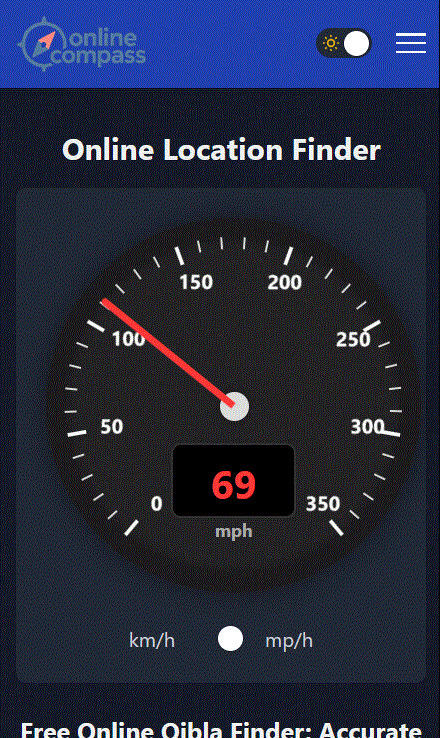How to Use the Online Speedometer
The speedometer displays your current speed. This speed is displayed in both analog and digital formats. In the analog model, the speed is displayed using a red needle. In the digital model, you can choose to display the speed in kilometers per hour or miles per hours. To display the speed, you must provide the necessary access to the GPS sensor of your device. If access is not provided, the speed cannot be displayed. A message appears asking you to provide the necessary access. By clicking the Allow button, provide access to GPS information in the browser.



A video of how the speedometer works can be seen below:
How Speedometer Works?
A speedometer works by using signals from GPS to calculate how fast an object is moving. The Global Positioning System (GPS) consists of a network of satellites that continuously transmit their position and the exact time the signal was sent. A GPS receiver, such as the one in your smartphone or car, detects signals from at least four of these satellites to determine its exact location on Earth through a process called trilateration. To measure speed, the receiver compares its position at two points in time and divides the distance traveled by the time elapsed. This gives the real-time speed of the object. The GPS updates this information frequently—often every second—allowing it to provide a nearly continuous and accurate reading of speed. Unlike traditional speedometers that rely on wheel rotation, GPS-based speedometers are not affected by tire size, wheel slip, or mechanical issues, making them especially useful for activities like running, cycling, or off-road driving. However, they can lose accuracy when the signal is blocked, such as in tunnels or dense urban areas.

When and Why to Use a Speedometer
Speedometers are used in various cases, including measuring speed while driving, cycling, observing the speed limit and avoiding speeding fines, and monitoring the speed of transport fleets.
How does an online speedometer work to measure speed?
An online speedometer works by using GPS signals to calculate how fast you're moving. The online speedometer receives signals from GPS satellites and uses trilateration to determine your exact location, then compares your position at two points in time and divides the distance traveled by time elapsed. The online speedometer updates frequently, often every second, to provide nearly continuous and accurate speed readings.
What display formats does the online speedometer offer?
The online speedometer displays your current speed in both analog and digital formats. In the analog format, the online speedometer shows speed using a red needle on a traditional gauge display. In the digital format, you can choose to display speed in either kilometers per hour (km/h) or miles per hour (mph) according to your preference.
What permissions does the online speedometer need to function?
The online speedometer requires access to your device's GPS sensor to display speed accurately. You must click the Allow button to provide GPS access in your browser when the permission message appears. Without this access, the online speedometer cannot function properly or display your current speed, as it relies entirely on GPS data for speed calculations.
When and why should I use an online speedometer?
An online speedometer is useful for measuring speed while driving when your car's speedometer may be inaccurate, cycling to track your pace, observing speed limits to avoid speeding fines, and monitoring the speed of transport fleets. The online speedometer is especially valuable because unlike traditional speedometers, it's not affected by tire size, wheel slip, or mechanical issues, making it ideal for activities like running, cycling, or off-road driving.

